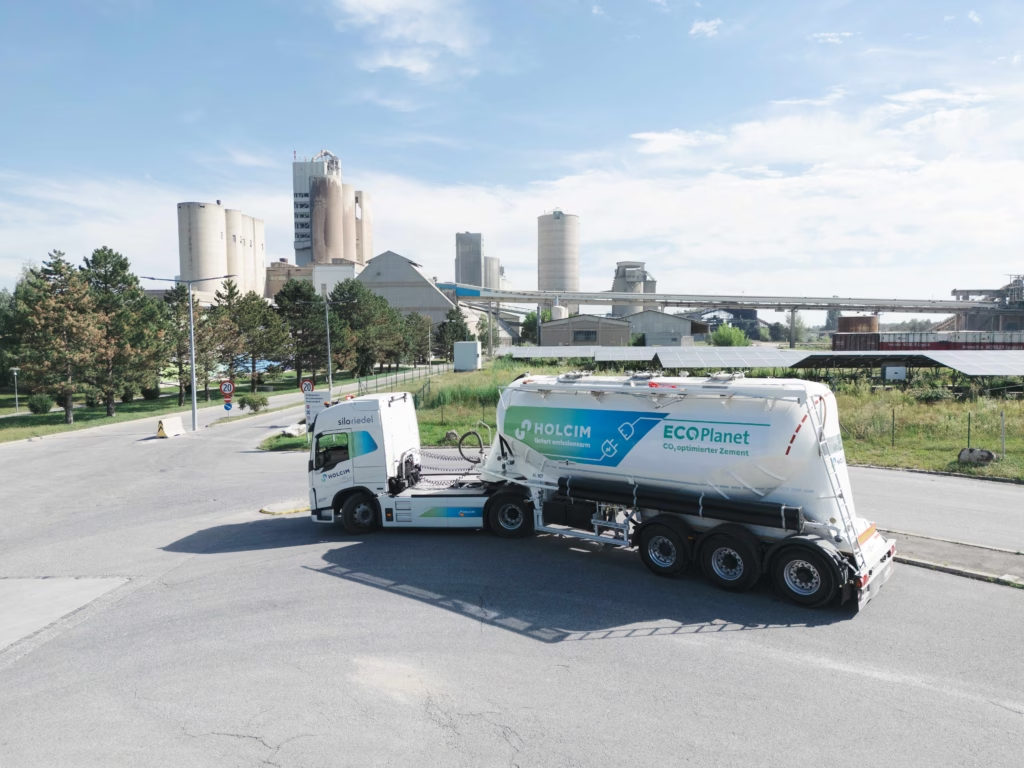Silo-Riedel delivers Holcim cement by electric truck.

Silo Riedel has been driving the first electric tractor unit with a compressor for cement loading on behalf of Holcim since late summer. "With the transformation of mobility and the building sector, we can make a positive contribution to two of the strongest levers towards sustainability. We are delighted that our transport partner Silo Riedel, as a driver of innovation, is putting the first all-electric tractor unit for the delivery of loose cement on the road in Austria. In doing so, we are also supporting our customers, whose footprint of building materials and logistics is being incorporated into their sustainability assessment systems. Incidentally, the new truck is transporting EU taxonomy-compliant cement, our ECOPlanet ROT CEM II/CM (S-LL) 42.5 N," says Gernot Tritthart, Director of Marketing & Sales at Holcim Austria.
Silo Riedel is a pioneer with the solution it has developed for loose cement transport. "As a partner of Holcim, we are pleased to have taken a significant step toward sustainable transport solutions: Austria's first CO₂-neutral delivery of dust in a silo using a fully electric truck. The delivery was made using an emission-free, low-noise electric truck powered exclusively by certified green electricity. By using state-of-the-art electromobility, we were not only able to reduce local emissions to zero, but also make the entire transport service climate-neutral – an important signal for future-oriented, resource-saving logistics. We are proud to work with Holcim on innovative solutions for a CO₂-reduced value chain and to actively contribute our expertise in the field of sustainable transport technology," says Julia Heißenberger, Managing Director of Silo Riedel.
Silo Riedel's new electric truck primarily operates for Holcim from the Mannersdorf cement plant and, in the interest of sustainability, is also optionally used for return deliveries. The main destination for cement deliveries is currently Seestadt Aspern, an urban expansion area that is committed to the greatest possible reduction in emissions, not only in construction.
E-mobility target with 80% share by 2030 at Holcim
"With this conversion, we will be able to deliver a significant proportion of cement in a climate-friendly manner by 2025. We plan to deliver around 80% of the volume delivered on behalf of Holcim in Austria by electric vehicles by 2030," says David Zepmeisel, Supply Chain Manager & Head of CEM Logistics at Holcim Austria. "In addition to individual truck transport, we are also expanding rail transport, especially for the delivery of raw materials and substitute fuels in line with our Net Zero strategy."
Cement is a "local supply" building material, meaning it is usually transported within a radius of no more than 150 kilometers, which is why the majority of its transport is carried out via flexible truck fleets.
Investments in charging infrastructure
To further expand the charging infrastructure, both Holcim and Silo Riedel are planning investments at their own sites, as well as collaborations with external service providers. Preparations for the construction of charging stations have already begun at the Holcim factory site in Mannersdorf. "The transition to alternative drive systems such as e-mobility is crucial for achieving climate targets. The expansion of efficient charging infrastructure and high-performance, stable networks, including at production and logistics sites, is an important requirement for a functioning industrial location in the future," says Tritthart.
CO2 reduction of around 85% compared to diesel trucks achieved
Compared to conventional, diesel-powered trucks, approximately 85% of CO2 emissions can be saved. Holcim itself does not operate its own fleet in Austria, but the company has already introduced Europe-wide purchasing programs for e-mobility in 2023, which service providers can also use. Holcim's goal is to reduce Scope 3 emissions by 90% by 2050.
Silo Riedel's objectives for electromobility
By using electric tractor units, Silo Riedel pursues the following goals:
- Environmental protection and contribution to national and international climate goals through the reduction of CO2 emissions, the improvement of air quality and the reduction of noise and sound levels
- Energy and resource efficiency by increasing energy efficiency through better efficiency of the electric motor and promoting renewable energies through operation with green electricity.
- Technological innovation and competitiveness by promoting innovation in the transport sector and strengthening domestic value creation through technological leadership.
